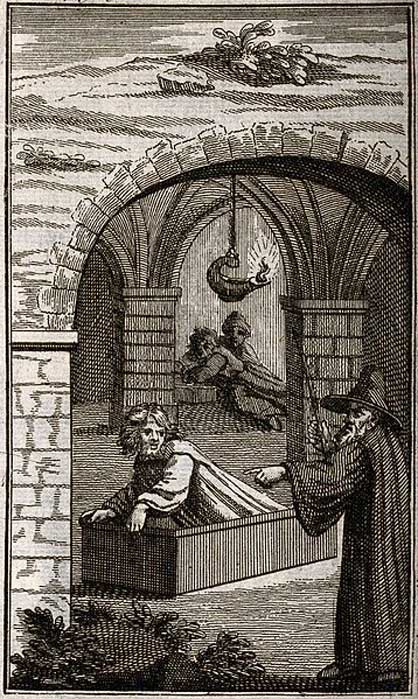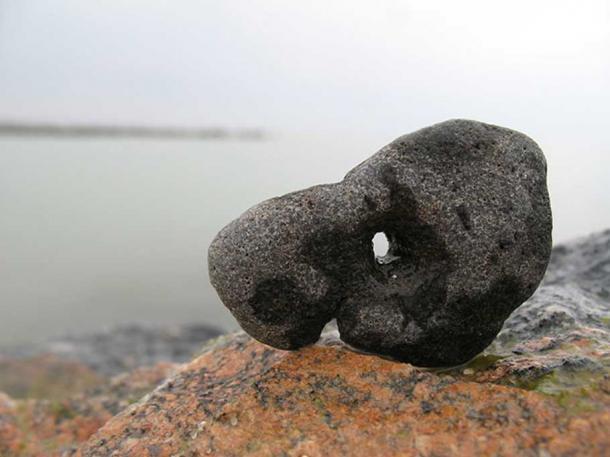
A Spellbinding Story of Discovery: A Medieval Grave for a Wizard and a Magical Artifact
Powerful wizards, warlocks, and sorcerers wielding supernatural staffs and spells have captivated our imaginations for thousands of years. Characters like Merlin, Gandalf, Dumbledore, and Yoda are icons of popular culture and continue to spellbind both children and adults. These fictional characters were in a great part inspired by real life people who dedicated their lives to developing scientific thought, hermetic philosophy, divination, and priestcraft. By the 16th century every Royal Court in Europe employed at least one in-house alchemist who blended esotericism and natural philosophy into a rich system of magical thought. This story recounts the discovery of a medieval wizard’s grave and the magical artifact I unearthed there, which still completely mystifies me.
Uaigh Mhurcha Riabhaich
I was brought up in Caithness in the north east of Scotland and for many years I had been fascinated as to why the 1871 Ordnance Survey 25″ map depicted a dotted circle bearing the title Uaigh Mhurcha Riabhaich (ND 2454 5479). We recently filmed at this location as story is being featured in an upcoming episode of The People’s History Show on STV. A little research revealed that the name had been associated with this remote spot at the east-end of Loch Watten for over 600 years.

Ordnance Survey 25″ map of Caithness (1871). (Author provided)
Taking the Wizard’s Head
Caithness folk in the village of Watten still tell their children the tale of a powerful wizard who was murdered, decapitated, and buried in a circular grave at the end of the loch. This folktale was recorded with many others by James Calder in his 1887 History of Caithness. Between 1350 and 1372 Paul Macintyre of Creichmore’s sent his son Gillespie north to Caithness to collect cows in lieu of late rents. His small militia was led by Murdo Rivach Mackenzie, a respected Highland warrior and sorcerer. While heading south with a herd of cows they were ambushed at the east end of Loch Watten by a gang of Caithness men, who murdered Gillespie and Murdo.
- Blurring the Between Magic and Philosophy: Legendary Wizards of the Ancient World
- The Fantastic Adventures of Vainamoinen: Finnish Hero, Wizard, Shaman, and God
- The Legendary Origins of Merlin the Magician
Being a wizard, Murdo was quickly decapitated and his body was burned where it fell. His head was taken south with Gillespie's corpse and crossing the Ord (A9 road) the party squabbled and Murdo's head was lost over a cliff while Gillespie's body was washed away as they tried to cross the River Helmsdale. It is written that Murdo's magically imbued battle sword was preserved for some time by the Budges of Toftingall - who eventually returned it to Kenneth Mackenzie of Seaforth in 1688. Little more is known about Murdo Rivach other than that he was regarded as a brave outlaw and a powerful wizard.

A wizard conjuring a man from his grave. Etching. (Wellcome/CC BY 4.0)
What Was Murdo Rivach?
The name Murdo is Celtic in origin and in contemporary Gaelic it means ‘Sea Warrior’. It’s possible the circular grave is that of an important Norse chieftain, priest or shaman, an idea supported in the fact that in 1954, only 600 meters (1968.5 ft.) upstream archaeologists discovered the grave of a woman from the Viking era. Furthermore, in William. F. Skene’s 1886 book Celtic Scotland, he tells of a battle between Ljotr/Liot, a powerful 10th century Norse Jarl of Caithness and Orkney and a Scottish earl called Magbiod (Macbeth) which fought at Skida Myre (Skitten Moor) near Watten. Having won the battle, Ljotr died of his wounds shortly after and was buried at Stenhouse near Watten. His grave is said to be marked by a stone named Stone Hone which is located only 500 meters (1640.4 ft.) NNW of Murdo Rivach’s grave.
Just 200 meters (656.2 ft.) south of Murdo Rivach’s grave, at Greystones Farm, a single standing stone penetrates a field and the remains of a standing stone circle is located 600 meters (1968.5 ft.) upstream. A few miles north in the parish of Bower another standing stone, called Stone Lud, was the favored marker for Victorian Historians trying to identify the burial site of Jarl Ljot. However, it can be said with confidence that both Stone Hone and Stone Lud were erected in the Neolithic era (4000-2000 BC) and neither are Viking grave markers.

Standing Stone Lud, the mythical burial site of Ljot. (Grid Ref: ND222617) (Author provided)
Where and How Was Murdo Buried?
The 1871, Ordinance Survey Name Book reads; “This is rather a peculiar feature situated about 120 yards south from the S.E. end of Loch Watten, in a field close to the public road; its formation is circular being about 60 links (approx. 391/2 ft.) in diameter, possibly at one time trenched round.” The OS mappers suspected the site was possibly a Danish (Viking) camp because it was circular in construction and made of a type of clay which was totally different from neighboring fields.
The Royal Commission of Ancient and Historical Monuments (RCAHM) has several entries about this site: In 1872, it was recorded as a possible Danish camp (a circular construction of clay about 60 links in diameter,) and it was noted that "a wizard named Mhurcha Riabhach was shot and buried here about 1720.” In 1963, a record states “ the only trace of the feature is a very slight depression 13.3m in diameter, in an arable field.” In 1982, there was no change to the previous field report and in 1995 it was noted that it was "a slight depression but covered in hay ricks.”
Turn towards Loch Watten at the Brown Trout Hotel. The grave site is 700 meters (2296.6 ft.) along the road on the right-hand side.

Location of Murdo Rivach’s grave. (Author provided)
Discovering the Adder Stone
I set out one weekend in 2012 to locate Murdo Rivach’s Grave and upon measuring the diameter of the circle, outwards from its center, a curiously shaped stone peered at me through the top soil.

Author Ashley Cowie with the artifact recovered from Murdo's grave. (Author provided)
This piece of sandstone had spent many millennia in the sea and its edges appear to have been serrated, but this might be damage resulting from its oceanic origins or ploughing. Two of the stones faces, and one edge, resemble human faces with two eyes and mouths. In many countries, this find could be dismissed as ‘just a stone’ but when interpreted against its social background it might be much, much more.

Face 2; edge of the stone. (Author provided)
Holed stones were regarded as magical as early as the beginning of the second millennium BC (Murray,1943) "Perforated stone amulets were not only seen as hostile to the multifarious crafts of witches but also…protective against the much dreaded evil eye…as such these stones were deliberately placed with three in a room and one in a grave.” (Elworthy, 1903).
Similar natural stones with human faces have been recovered in North Germany, Egypt, and Scotland, where “stones with natural holes in them, forming faces, were formerly believed to have magical powers of various kinds.” (Hole, 1980; Edwards, 2008). In ancient Egypt, natural stones with human faces were called aggry or aggro and were central to rituals and ceremonies.
Historically, in Scotland these stones go by several names: Holey Stones, Witch Stones, Mare-Stones, Wish Stones, Hag Stones, Druids’ Stones, Druids’ Eggs, and Serpent Eggs. In the south of Scotland, they were most commonly ‘Adder Stanes’ and in the north, where Scottish Gaelic prevailed, they were called ‘Gloine nan Druidh’ – ‘Druids Glass’. Adder stones were held in extremely high esteem, "the most distinguishing articles of Druidic decoration”.
- The Mystery of the Four Golden Hats of the Bronze Age
- Tomb of the Tattooed Sorceress Queen, The Lady of Cao
- Meet Father Frost and his Fairy Goddaughter Snow Maiden: Magical Characters of Winter from Russia

A collection of threaded Adder Stones. (Author provided)
They were used to protect people and their possessions against negative forces and were most often hung in windows and above doorways. They were also placed above beds to protect sleepers from nightmares, perceived as working in a similar way to native American dream-catchers. Albeit the perceived powers of these stones varied from place to place, depending on the local customs and traditions. All across Scotland farmers used them to protect their fields from demons spreading disease and wolves attacking their livestock. In 17th century Scotland and Norway, mariners guarded their ships against violent sea witches and fatally seductive fin-folk (half seal-half human creatures in Norse mythology) by attaching these stones to their hulls.
Adder stones were sometimes placed in fields and on doorsteps to protect people, animals, and harvests against curses/hexes and belief in their healing properties was widespread - especially their ability to cure snake bites. When worn as an amulet/pendant around the neck they were thought to aid overall healing, ease painful wounds, and offer spiritual protection against witches and witchcraft, on land and at sea.

Stone with a hole (hagstone or Adder stone). (CC BY SA 3.0)
Conclusions
All over Europe, ancient peoples believed that holes in natural features were portals or gateways into the fairie dimension, populated with mythical Fae folk, giants, elves, demons, and spirits. Myths recount people looking at the full moon through honey stones and whispering wishes and spells. To have discovered one on a wizard’s grave is a remarkable cultural find and the full story of the holed stone and the wizards grave will be featured on Season 2 of STV’s the People’s History Show.
Top Image: ‘Merlyn’ a wizard. Source: Ishtaure Dawn/CC BY SA 2.0
By Ashley Cowie
Ashley Cowie is an author, researcher, explorer, film-maker and blogger about lost cultures and kingdoms, ancient crafts and arts, the origins of legends and myths, architecture, iconography, artifacts and treasures. Visit- https://ashleycowie.com















